Arief Rubianto will be speaking at the Wildlife Conservation Network Expo in San Francisco on October 3rd, 2010.
Arief Rubianto, the head of an anti-poaching squad on the Indonesian island of Sumatra best describes his daily life in this way: “like mission impossible”. Don’t believe me? Rubianto has fought with illegal loggers, exchanged gunfire with poachers, survived four days without food in the jungle, and even gone undercover—posing as a buyer of illegal wildlife products—to infiltrate a poaching operation. While many conservationists work from offices—sometimes thousands of miles away from the area they are striving to protect—Rubianto works on the ground (in the jungle, in flood rains, on rock faces, on unpredictable seas, and at all hours of the day), often risking his own life to save the incredibly unique and highly imperiled wildlife of Sumatra.
As the current head of the Intelligence and Law Enforcement Unit with the International Rhino Foundation (IRF) on the island of Sumatra, Arief has a life that would a writer on Law and Order jealous. He splits his time between the office and the field: managing anti-poaching operations on the ground while working with government officials, law enforcement officers, and lawyers on locating, catching, and punishing perpetrators of wildlife crime. At stake is the extinction of a number of greatly imperiled animals, some of which are only found on the island of Sumatra.
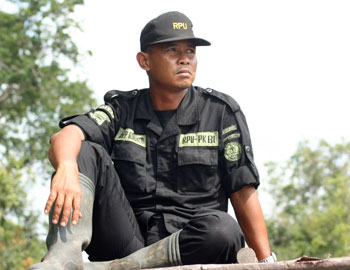 Arief Rubianto in his Rhino Protection Unit (RPU) uniform on a boat patrol. Photo courtesy of: Arief Rubianto. |
He told mongabay.com that “the priority is the rhino [i.e the Sumatran rhino (Dicerorhinus sumatrensis)], because the rhino is more endangered than other wildlife in Indonesia. They live solitary in the deep forest with difficulty in breeding. We still lack information about population, behavior etc. We need support from all of stakeholders [if the rhino is to be saved from extinction].”
One of the world’s most elusive mammals—known as being impossible to see in the wild—Rubianto has encountered the Sumatran rhino on a number of occasions including a dying rhino caught in a snare trap when, prior to his current job, he worked as the head of a Rhino Protection Unit (RPU). While snares are rarely meant for rhinos, they pose a particular threat to this species. Rubianto says on one memorable patrol of the forest the team collected 600 snares.
Rubianto does not mince words about the future of Sumatra wildlife: “I believe that only 40 % of Sumatran wildlife will still survive in 10 years time, if us—government and stakeholders—do not change our actions immediately.”
Working closely with local communities to prevent illegal hunting, catch poachers, and support conservation efforts is key for conservation efforts according to Rubianto, who also says that government officials and staff must stop treating the ownership or use of wildlife products as a status symbol.
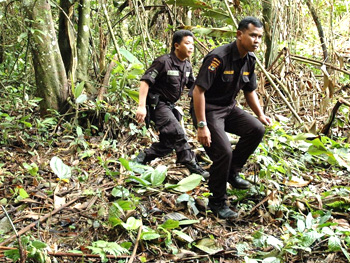 RPU moving in to arrest suspect on law enforcement operation. Photo courtesy of: Arief Rubianto. |
Overall “some [conservation] programs have a good result. [But] most areas are worse if we compare the wildlife population in each since 10 years ago” Rubianto concludes, though this has not dampened his resolve in saving Indonesia’s species.
In a September 2010 interview Arief Rubianto spoke about the daily challenges of fighting poaching in Sumatra, including weak laws, mixed messages from the government, and violent conflict with perpetrators. He also shared a few of his adventures in working to save some of the world’s most threatened mammals.
Rubianto will be presenting at the up-coming Wildlife Conservation Network Expo in San Francisco on October 3rd, 2010.
INTERVIEW WITH ARIEF RUBIANTO
Mongabay: What is your background?
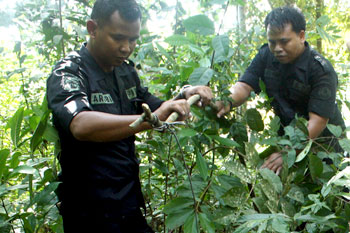 RPU demonstrating how to find and disable a snare. Photo courtesy of: Arief Rubianto. |
Arief Rubianto: I was schooled as veterinarian. I was born and grew up in Bandung city (capital city of West Java). My father worked as intelligence army. I learned about intelligence from him.
Mongabay: How did you become interested in wildlife?
Arief Rubianto: Since young, I have been farming with many animals. I really like interacting with animals. In 1993 I had the opportunity to join with the UK’s Sumatran Rhino Survey Project. I really enjoy my job.
SUMATRAN WILDLIFE
Mongabay: You’re currently the head of the Intelligence and Law Enforcement Unit with the International Rhino Foundation (IRF). What is a normal day like for you?
Arief Rubianto:
1. Make sure the informant network is still operating in the field.
2. Make sure the patrol unit working effectively on the target area.
3. Cross check information and prepare for special operations to arrest suspects.
4. Coordination with National Park, Forestry and Forest Rangers, police, local government, prosecutors, others NGOs, the press and others.
5. Write reports.
6. Visit field to cross check the latest condition and support to handle wildlife conflict.
7. Visit villagers and farmer groups to gain support from them for long term target of conservation.
Mongabay: Which species do you focus on?
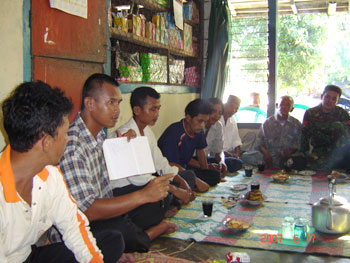 RPU has discussion with local villagers about conservation and agriculture. Photo courtesy of: Arief Rubianto. |
Arief Rubianto: The priority is the rhino [i.e the Sumatran rhino (Dicerorhinus sumatrensis)], because the rhino is more endangered than other wildlife in Indonesia. They live solitary in the deep forest with difficulty in breeding. We still lack information about population, behavior etc. We need support from all of stakeholders [if the rhino is to be saved from extinction]. Of course elephant, tiger and other wildlife have the same habitat and must be protected too.
Mongabay: What are the greatest threats for the wildlife of Sumatra?
Arief Rubianto: The biggest threat is poaching. [Other threats include] habitat loss or forest conversion to agriculture; decrease of genetic population, in-breeding and unsuccessful breeding; and limited protection program and networking for wildlife of Sumatra.
Mongabay: You work with one of the world’s most endangered and elusive mammals: the Sumatran rhino. Have you ever seen one in the wild, if so will you tell us about the encounter?
Arief Rubianto: Yes, I have seen more than 5 times.
1. 1993 in Kerinci Seblat National Park. The rhino in wallowing.
2. 1997 in Way Kamas NP. The rhino in wallowing.
3. 1998 in Bukit Barisan Selatan (BBS) NP. The rhino in wallowing.
4. 1999 in BBS NP. The rhino in wallowing.
5. 2000 in BBS NP. Male and female rhino walking.
6. 2000 in BBS NP. The rhino dying by snare trap.
7. 2004 in BBS NP. The rhino (Rossa now in Sumatran Rhino Sanctuary in Way Kambas NP) always live with us for one and a half years in the jungle.
Mongabay: Before becoming the head of the Intelligence and Law Enforcement Unit for IRF in Sumatra you headed a Rhino Protection Unit (RPU). Do you have any memorable moments from spending so much time trekking in the jungle?
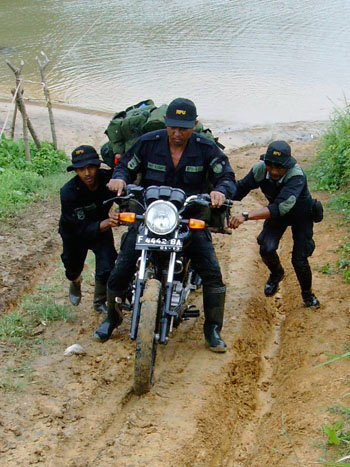 Using motorcycles on hilly roads. Photo courtesy of: Arief Rubianto. |
Arief Rubianto: Yes, this like mission impossible. RPU with limited sources must have high spirit and good teamwork to do their duty: many enemies and high risks to building conservation in a developing country. We must know how to touch the feeling of local people/ villagers because they are a big potential power to support conservation. Also, we must support alternative economic means for them.
Yes, [I had] many experience when we live in the jungle. Three times we had to move the camp in one night because of big floods. We crossed unbelievable area where all trees were broken until we passed the sixth hill.
In one trip patrol we find 600 traps. When three of us made a patrol once, we found and fought with seven illegal loggers. We climbed rock faces with limited equipment and with big rucksacks—one of us fell and was injured. Also, [the story of] how we survived for four days not eating because of unpredictable conditions in the field.
POACHING
Mongabay: Poachers, by their very nature, work secretively in a vast underground network. How do you catch them?
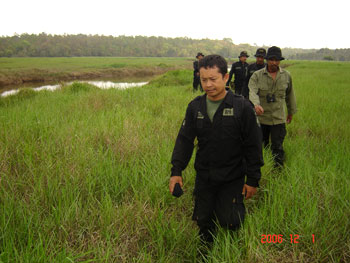 Patrolling in Way Kambas National Park. Photo courtesy of: Arief Rubianto. |
Arief Rubianto:
1. We have to know the field situation, habitat, wildlife distribution, law, culture of local village, key person from other institutions of law enforcement, and our resources.
2. Build the informant network that covers all of the habitat.
3. We have to know the networking and people involved in poaching and illegal trade.
4. Cross check this information from other informant or illegal market networking.
5. Observation all of the evidence to support the cases.
6. Prepare the operation and coordinate with other institutions.
7. Build the trust of local villages.
8. Monitoring and support the case after arresting the suspect, prosecution process until punishment.
Mongabay: What technology do you use to help you locate and arrest poachers?
Arief Rubianto: We use the GPS, walky-talky, personal cell phone, camera, and since 2010 we use the camera surveillance in the hand watch.
Mongabay: You’ve gone undercover in your job to infiltrate poaching groups. Have you ever felt in danger?
Arief Rubianto: Yes, many times we must fight with them. Mostly they use the gun and knife. Sometimes we have gun fire in the field.
Sometimes I have to go undercover to do a transaction with broker, but the most danger is when we have to arrest the suspect in their home near the jungle. We have to arrest the suspect from 3-5 AM when they sleep. We use car, motorcycle or boat rental to cross the sea in the night with unpredictable conditions.
Mongabay: Do you believe poaching is getting worse or better in Sumatra?
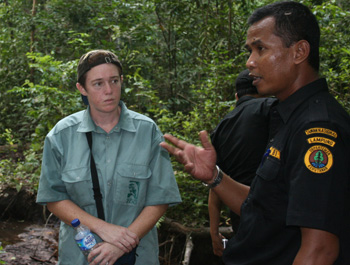 Rubianto discussing progress on the ground with donors. Photo courtesy of: Arief Rubianto. |
Arief Rubianto: I think every area has different situations and the condition is always changing. Some programs have a good result. [But] most areas are worse if we compare the wildlife population in each since 10 years ago.
Mongabay: In your view are the punishments strong enough for convicted poachers?
Arief Rubianto: Mostly the punishments are not good enough. We have experienced that if the cases have good local publication and have support from NGOs, the press, and other institutions, this will increase the punishment for poachers. With the highest punishment [currently in the law], will eliminate the risk of poaching and other illegal activity for next 3 years.
Mongabay: What additional laws would help you and colleagues improve enforcement of wildlife laws in Sumatra?
Arief Rubianto:
1. Punishment and rewards for government staff who do/do not support the cases and conservation.
2. Need higher punishment in conservation law.
3. Like the drug law, with the minimum evidence can bring the suspect to the jail, for example someone who has [possession of a] wildlife body part.
Mongabay: Is the public in Sumatra aware of the dangers to their unique wildlife?
Arief Rubianto: Some of them know about wildlife conservation in Sumatra, but there is not enough action from them. The most important is support and sample action from leader of the government and their staff, because some of them still use the wildlife body parts as a [symbol of] prestige to the public. Some poaching groups and illegal traders have support from government staff. Situation will become worse when the local villages follow that example.
FUTURE
Mongabay: Given the numerous pressures on Sumatran wildlife how optimistic are you that these species will survive?
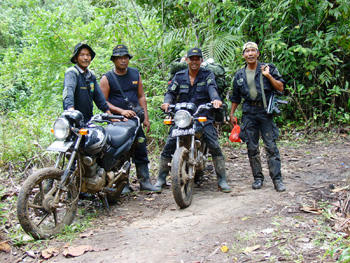 Using motorcycles increases the RPU’s ability to cover more ground. Photo courtesy of: Arief Rubianto. |
Arief Rubianto: I believe that only 40 % of Sumatran wildlife will still survive in 10 years time, if us—government and stakeholders—do not change our actions immediately. For now, only small sources of protection programs for those working in the jungle.
Mongabay: I read in an article that your wife and child live in Java. Is this still the case? How often do you get to see your family?
Arief Rubianto: Since I married in 1996, I have twelve times moved our home in three provinces. Since 2010 my family stayed in Java, because education for our child is important. I am back with my family every one to two months, for seven to eight days, depending on situation.
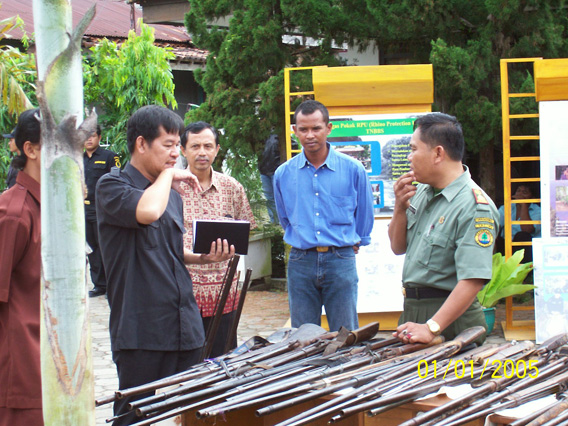
Ceremonial to destroy 90 illegal gun from local villages and poachers with National Park officials and RPU. Photo courtesy of Arief Rubianto.

RPU begins a patrol. Photo courtesy of Arief Rubianto.
Related articles
Face-to-face with what may be the last of the world’s smallest rhino, the Bornean rhinoceros

(12/01/2009) Nothing can really prepare a person for coming face-to-face with what may be the last of a species. I had known for a week that I would be fortunate enough to meet Tam. I’d heard stories of his gentle demeanor, discussed his current situation with experts, and read everything I could find about this surprising individual. But still, walking up to the pen where Tam stood contentedly pulling leaves from the hands of a local ranger, hearing him snort and whistle, watching as he rattled the bars with his blunted horn, I felt like I was walking into a place I wasn’t meant to be. As though I was treading on his, Tam’s space: entering into a cool deep forest where mud wallows and shadows still linger. This was Tam’s world; or at least it should be.

(07/29/2010) Many of the environmental issues facing Indonesia are embodied in the plight of the orangutan, the red ape that inhabits the islands of Borneo and Sumatra. Orangutan populations have plummeted over the past century, a result of hunting, habitat loss, the pet trade, and human-ape conflict. Accordingly, governments, charities, and concerned individuals have ploughed tens of millions of dollars into orangutan conservation, but have little to show in terms of slowing or reversing the decline. The same can be said about forest conservation in Indonesia: while massive amounts of money have been put toward protecting and sustainable using forests, the sum is dwarfed by the returns from converting forests into timber, rice, paper, and palm oil. So orangutans—and forests—continue to lose out to economic development, at least as conventionally pursued. Poor governance means that even when well-intentioned measures are in place, they are often undermined by corruption, apathy, or poorly-designed policies. So is there a future for Indonesia’s red apes and their forest home? Erik Meijaard, an ecologist who has worked in Indonesia since 1993 and is considered a world authority on orangutan populations, is cautiously optimistic, although he sees no ‘silver bullet’ solutions.
Large-scale forest destruction in Sumatra undermines Indonesia’s deal with Norway

(07/13/2010) While the Indonesian government basks in a recent agreement with Norway to slow deforestation to the tune of a billion US dollars, a new report by Eyes on the Forest shows photographic evidence of largely government sanctioned deforestation that flouts several Indonesia laws. Potentially embarrassing, the report and photos reveal that two companies, Asian Pulp and Paper (APP) and Asia Pacific Resource International (APRIL), have destroyed 5 percent of Riau province’s forests since 2009, including deep peatlands, high conservation value forests (HCVF), Critically Endangered Sumatran tiger habitat, and forest within the Giam Siak Kecil- Bukit Batu UNESCO Biosphere Reserve. In total, over 130,000 hectares (an area larger than Hong Kong) of mostly peat forest were destroyed for pulp.
Sumatran rhino loses pregnancy: conservationists saddened but remain resolute
(03/31/2010) Rhino conservationists’ hopes were dampened today by news that Ratu, a female Sumatran rhino, had lost her pregnancy. Just months after the announcement of the pregnancy—the first at Indonesia’s Sumatran Rhino Sanctuary in Way Kambas National Park—Ratu lost the embryo. Still, say conservationists, the very fact that Ratu became pregnant at all should keep hope alive for the beleaguered species.
Illegal loggers hit community reforestation project in Indonesia, spurring questions about REDD
(02/22/2010) Illegal loggers are targeting community-managed forests in South Sumatra, renewing questions over forestry governance and law enforcement as the Indonesia prepares to capitalize on payments for conservation and reforestation under a proposed climate change mitigation mechanism known as REDD, reports the Jakarta Press.
REDD may not be enough to save Sumatra’s endangered lowland rainforests

(11/24/2009) A prominent REDD project in Aceh Indonesia probably won’t be enough to save Northern Sumatra’s endangered lowland rainforests from logging and conversion to oil plantations and agriculture, report researchers writing in Environmental Research Letters. The study highlights the contradiction between the Ulu Masen conservation project; which involves Flora and Fauna International, Bank of America, and Australia-based Carbon Conservation, a carbon trading company and the continuing road expansion, and establishment of oil palm plantations in the region.
40% of lowland forests in Sumatra and Indonesian Borneo cleared in 15 years
(11/10/2009) Forty percent of lowland forests in Sumatra and Kalimantan (Indonesian Borneo) were cleared from 1990 to 2005, reports a new high resolution assessment of land cover change in Indonesia.
Forests versus oil palm plantations in Sumatra
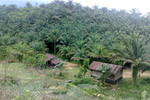
(10/14/2009) A chainsaw chugs into life and tears into the trunk of a tree as tall as a two-story house. Petrol and man work together as the chain sets its teeth into the wood and edges its way through. The tree creaks, leans, and falls with a great crash to a backdrop of whoops and cheers. The sight and sound of tree felling is common in Indonesia, the country with the highest rate of deforestation in the world. The destruction of forests in this archipelago, draped like an emerald necklace across the equator, can be measured in hectares per minute. Today, though, is a good day for the conservationists.
Two Sumatran elephants shot dead in Indonesian park
(03/31/2009) As reported by the Associated Press, two 20-year-old female Sumatran elephants were found on March 24th dead in the forests of Kerinci National Park due to gunshots in the head. The females had been partners with local rangers, who rode them to patrol the park to keep out illegal loggers.
Rash of tiger attacks linked to deforestation by large paper corporation APP

(03/18/2009) The Sumatran tiger, a critically-endangered subspecies, is hanging on by a thread in its island home. Biologists estimate that at most 500 individuals remain with some estimates dropping as low as 250. Despite the animal’s vulnerability, large-scale deforestation continues in its habitat mostly under the auspices of one of the world’s largest paper companies, Asian Pulp and Paper (APP). Shrinking habitat and human encroachment has led to a rise in tragic tiger encounters, causing both human and feline mortalities.
Tigers continue killing rampage in Indonesia
(03/03/2009) Two more illegal loggers were attacked and killed Sunday night in Sungai Gelam district in Jambi Province on the island of Sumatra, reports the Jakarta Post. The deaths bring the total number of people killed by tigers in the province since January 24th to nine.